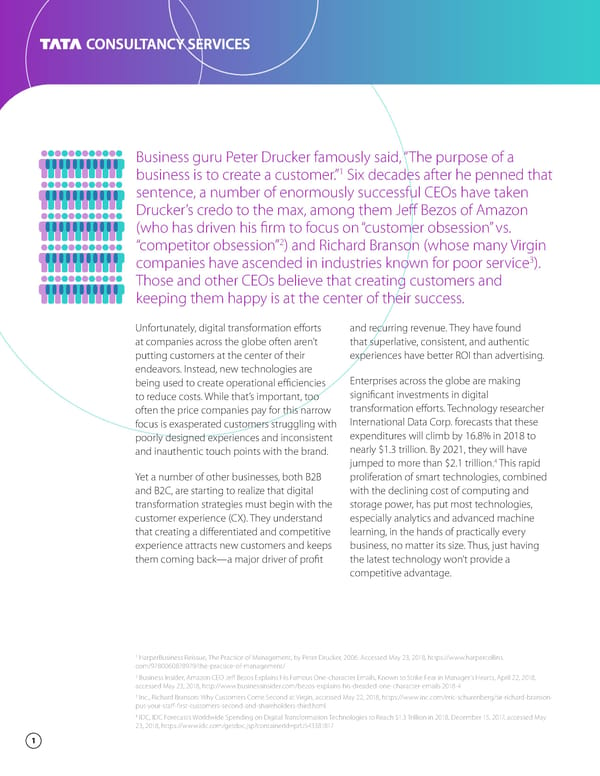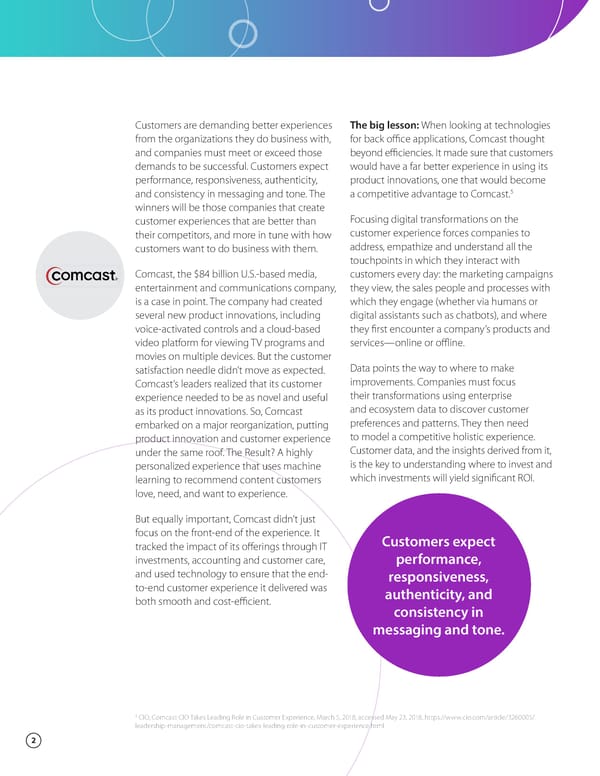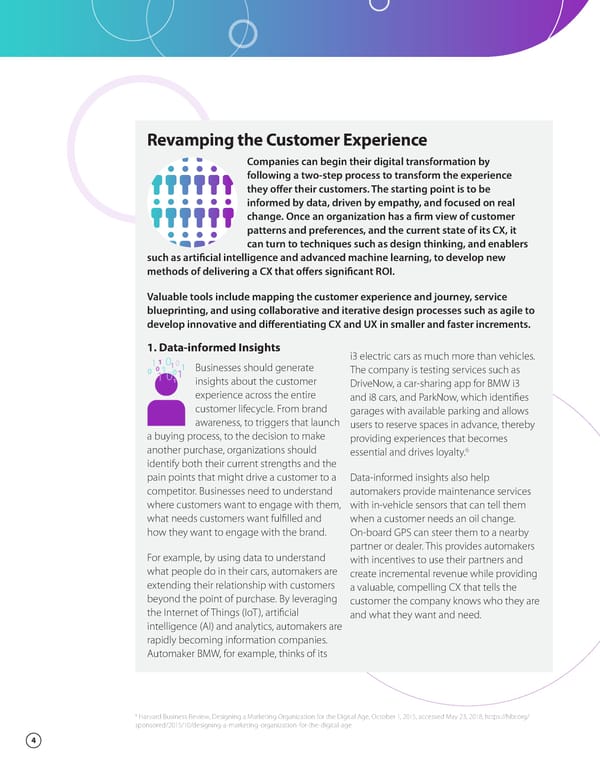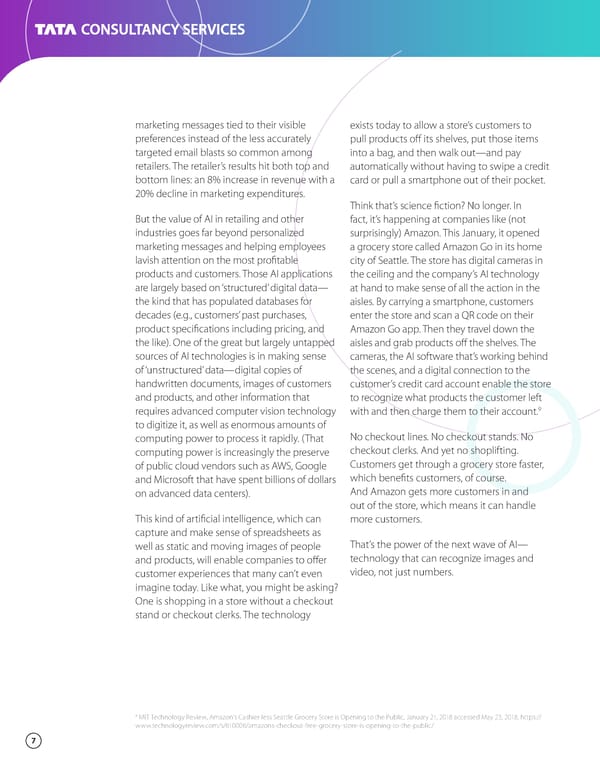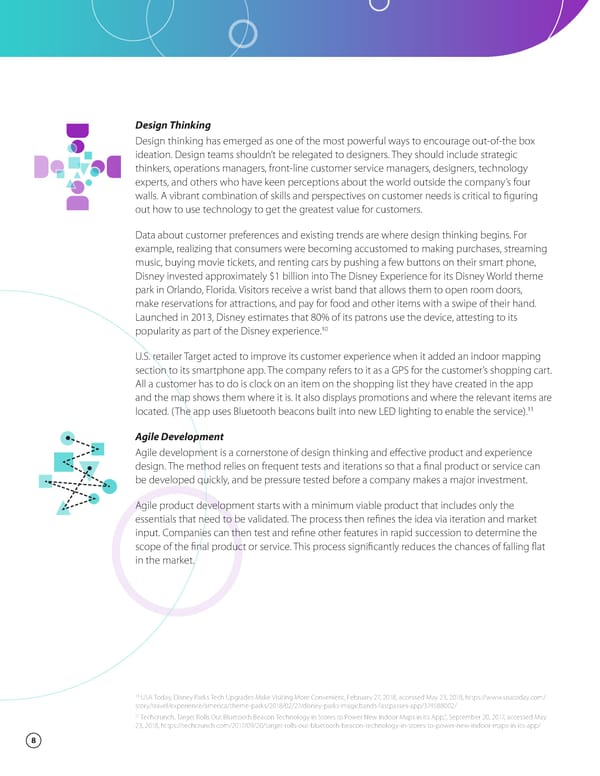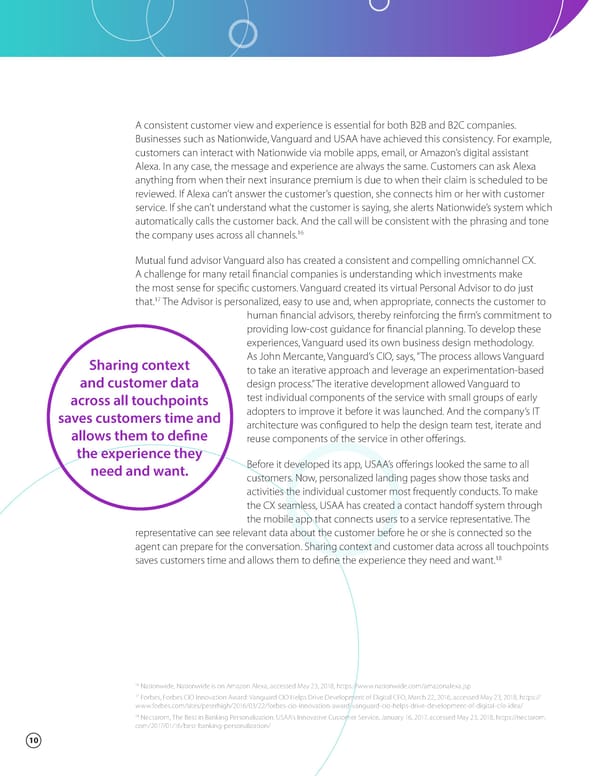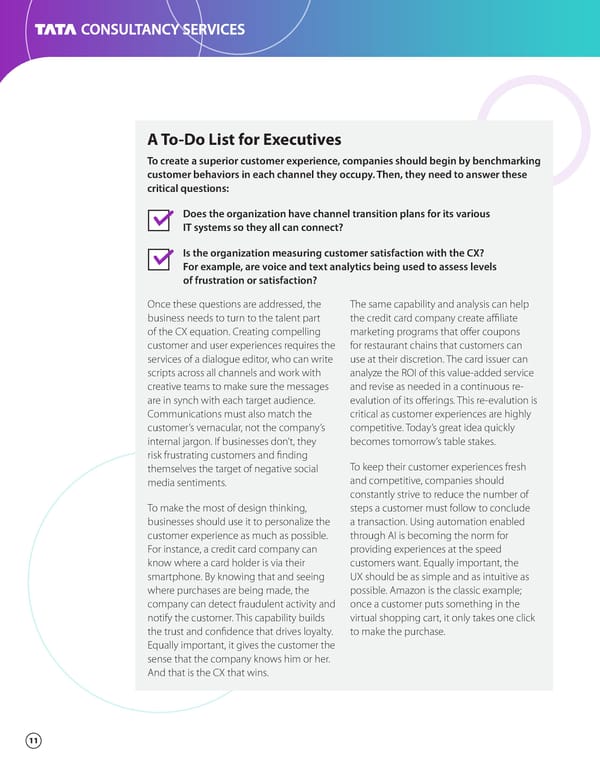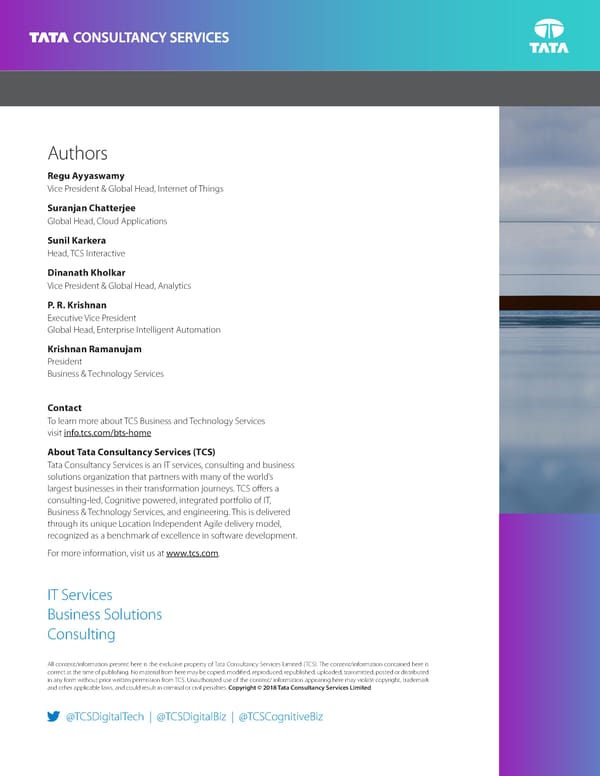Digital Transformation Starts with CX
READ | 10 mins
Thought Leadership Report | Business & Technology Services Digital Transformation Should Start with the Customer Experience

This is a modal window.
Business guru Peter Drucker famously said, “The purpose of a 1 business is to create a customer.” Six decades after he penned that sentence, a number of enormously successful CEOs have taken Drucker’s credo to the max, among them Jeff Bezos of Amazon (who has driven his firm to focus on “customer obsession” vs. 2 “competitor obsession” ) and Richard Branson (whose many Virgin 3 companies have ascended in industries known for poor service ). Those and other CEOs believe that creating customers and keeping them happy is at the center of their success. Unfortunately, digital transformation efforts and recurring revenue. They have found at companies across the globe often aren’t that superlative, consistent, and authentic putting customers at the center of their experiences have better ROI than advertising. endeavors. Instead, new technologies are being used to create operational efficiencies Enterprises across the globe are making to reduce costs. While that’s important, too significant investments in digital often the price companies pay for this narrow transformation efforts. Technology researcher focus is exasperated customers struggling with International Data Corp. forecasts that these poorly designed experiences and inconsistent expenditures will climb by 16.8% in 2018 to and inauthentic touch points with the brand. nearly $1.3 trillion. By 2021, they will have 4 jumped to more than $2.1 trillion. This rapid Yet a number of other businesses, both B2B proliferation of smart technologies, combined and B2C, are starting to realize that digital with the declining cost of computing and transformation strategies must begin with the storage power, has put most technologies, customer experience (CX). They understand especially analytics and advanced machine that creating a differentiated and competitive learning, in the hands of practically every experience attracts new customers and keeps business, no matter its size. Thus, just having them coming back—a major driver of profit the latest technology won’t provide a competitive advantage. 1 HarperBusiness Reissue, The Practice of Management, by Peter Drucker, 2006. Accessed May 23, 2018, https://www.harpercollins. com/9780060878979/the-practice-of-management/ 2 Business Insider, Amazon CEO Jeff Bezos Explains His Famous One-character Emails, Known to Strike Fear in Manager’s Hearts, April 22, 2018, accessed May 23, 2018, http://www.businessinsider.com/bezos-explains-his-dreaded-one-character-emails-2018-4 3 Inc., Richard Branson: Why Customers Come Second at Virgin, accessed May 22, 2018, https://www.inc.com/eric-schurenberg/sir-richard-branson- put-your-staff-first-customers-second-and-shareholders-third.html 4 IDC, IDC Forecasts Worldwide Spending on Digital Transformation Technologies to Reach $1.3 Trillion in 2018, December 15, 2017, accessed May 23, 2018, https://www.idc.com/getdoc.jsp?containerId=prUS43381817 1
Customers are demanding better experiences The big lesson: When looking at technologies from the organizations they do business with, for back office applications, Comcast thought and companies must meet or exceed those beyond efficiencies. It made sure that customers demands to be successful. Customers expect would have a far better experience in using its performance, responsiveness, authenticity, product innovations, one that would become 5 and consistency in messaging and tone. The a competitive advantage to Comcast. winners will be those companies that create customer experiences that are better than Focusing digital transformations on the their competitors, and more in tune with how customer experience forces companies to customers want to do business with them. address, empathize and understand all the touchpoints in which they interact with Comcast, the $84 billion U.S.-based media, customers every day: the marketing campaigns entertainment and communications company, they view, the sales people and processes with is a case in point. The company had created which they engage (whether via humans or several new product innovations, including digital assistants such as chatbots), and where voice-activated controls and a cloud-based they first encounter a company’s products and video platform for viewing TV programs and services—online or offline. movies on multiple devices. But the customer satisfaction needle didn’t move as expected. Data points the way to where to make Comcast’s leaders realized that its customer improvements. Companies must focus experience needed to be as novel and useful their transformations using enterprise as its product innovations. So, Comcast and ecosystem data to discover customer embarked on a major reorganization, putting preferences and patterns. They then need product innovation and customer experience to model a competitive holistic experience. under the same roof. The Result? A highly Customer data, and the insights derived from it, personalized experience that uses machine is the key to understanding where to invest and learning to recommend content customers which investments will yield significant ROI. love, need, and want to experience. But equally important, Comcast didn’t just focus on the front-end of the experience. It Customers expect tracked the impact of its offerings through IT investments, accounting and customer care, performance, and used technology to ensure that the end- responsiveness, to-end customer experience it delivered was authenticity, and both smooth and cost-efficient. consistency in messaging and tone. 5 CIO, Comcast CIO Takes Leading Role in Customer Experience, March 5, 2018, accessed May 23, 2018, https://www.cio.com/article/3260005/ leadership-management/comcast-cio-takes-leading-role-in-customer-experience.html 2
Why is Keeping the Customer in Mind So Hard? It’s easy to take one’s eye off the customer when tackling digital transformation. A common challenge is a relative dearth of accurate customer insight. Customer data is often trapped within the organizational silos of the sales, customer service, marketing, and finance departments—and can’t be linked to create a holistic view of the customer. A lack of usable, harmonized data inevitably leads to endless debate about what the customer experience should be, why, and where. As a result, transformation initiatives lose steam, and unsubstantiated assumptions can lead to futile outcomes. Moreover, businesses sometimes see CX solely either in terms of customer acquisition or customer service. Thus, they don’t think broadly about customer preferences and how to design an experience that caters to continuous engagement. Starbucks, in contrast, thinks about far more than the efficiencies of serving a cup of coffee. It is focused on delivering a superior in- store experience, going to great lengths to provide warm, comfortable and useful environments (providing Wi-Fi, for example) where people can socialize or work. (Just as important, the company also has an easy-to-understand loyalty program). A poorly designed CX transformation can actually worsen the overall experience a company provides customers. Individual functions chase digital ideas in a strategic vacuum. That may create efficiencies and productivity gains for themselves, but for no other part of the organization. And they also miss most, if not all, opportunities to use digital technology to improve brand awareness, customer acquisition, and customer retention. Indeed, not putting the customer experience first risks sending them running to competitors. If the user experience (UX) is confusing or clumsy, customers will run to competitors. And, if the CX and UX are not consistent across channels, and customers can’t do what they need to do, when and how they want, they are likely to look elsewhere for a better experience. Blockbuster learned a hard lesson about slighting the customer experience. The once-famous U.S. video retailer was not avoiding technology; it had invested in analytics to improve the profitability of its in-store video mix as the volume of available content rose. Its rival, Netflix, however, began with the customer experience, deploying an online recommendation engine that helped consumers find programming in the content cornucopia that best suited their interests and tastes. (Netflix also helped customers avoid having to go to video rental stores and find the videos they wanted were out of stock). At the same time, Blockbuster tried to guard its bottom line by maintaining its customer-hostile late fees, which customers detested. Netflix touted the fact that it had no such fees. Netflix thrived; Blockbuster failed, filing for bankruptcy in 2010. The lesson is that digital transformation efforts that don’t put the CX first can waste both money and effort. Or, as Blockbuster discovered, it can end the game for good. 3
Revamping the Customer Experience Companies can begin their digital transformation by following a two-step process to transform the experience they offer their customers. The starting point is to be informed by data, driven by empathy, and focused on real change. Once an organization has a firm view of customer patterns and preferences, and the current state of its CX, it can turn to techniques such as design thinking, and enablers such as artificial intelligence and advanced machine learning, to develop new methods of delivering a CX that offers significant ROI. Valuable tools include mapping the customer experience and journey, service blueprinting, and using collaborative and iterative design processes such as agile to develop innovative and differentiating CX and UX in smaller and faster increments. 1. Data-informed Insights i3 electric cars as much more than vehicles. 11 0 0 0 0 1 1 Businesses should generate The company is testing services such as 1 01 101 insights about the customer DriveNow, a car-sharing app for BMW i3 experience across the entire and i8 cars, and ParkNow, which identifies customer lifecycle. From brand garages with available parking and allows awareness, to triggers that launch users to reserve spaces in advance, thereby a buying process, to the decision to make providing experiences that becomes another purchase, organizations should 6 essential and drives loyalty. identify both their current strengths and the pain points that might drive a customer to a Data-informed insights also help competitor. Businesses need to understand automakers provide maintenance services where customers want to engage with them, with in-vehicle sensors that can tell them what needs customers want fulfilled and when a customer needs an oil change. how they want to engage with the brand. On-board GPS can steer them to a nearby partner or dealer. This provides automakers For example, by using data to understand with incentives to use their partners and what people do in their cars, automakers are create incremental revenue while providing extending their relationship with customers a valuable, compelling CX that tells the beyond the point of purchase. By leveraging customer the company knows who they are the Internet of Things (IoT), artificial and what they want and need. intelligence (AI) and analytics, automakers are rapidly becoming information companies. Automaker BMW, for example, thinks of its 6 Harvard Business Review, Designing a Marketing Organization for the Digital Age, October 1, 2015, accessed May 23, 2018, https://hbr.org/ sponsored/2015/10/designing-a-marketing-organization-for-the-digital-age 4
2. Thinking by Design This type of thinking has helped MassMutual, Design thinking puts the end a major U.S. insurer with $38 billion in user first and addresses their annual revenue. By collecting and analyzing environment and what they customer data, the company realized that need and want from a product any new life insurance product it created or service. For example, when was unlikely to appeal to the under 40 Lincoln redesigned its town car for the demographic. These consumers needed to Brazilian and Indian markets, it looked at the be educated about such a policy’s value to needs of luxury car users in a larger context. them. So, in 2014 MassMutual developed Both Brazil and India suffer from heavy traffic an education-focused buying experience and air pollution, so, Lincoln made the car based on what it called a ‘master’s program airtight. Because of endemic traffic delays, for adulthood.’ Instead of providing just business meetings are often held in cars, so, an online learning program, MassMutual Lincoln equipped them with tray tables and created a multi-channel experience 7 including state-of-the-art budgeting and other conveniences. financial tools, and a curriculum ranging Design thinking must be informed by rich from investing in a 401(k) retirement data sets about customers and their account to buying good value wine. The environments. These insights lead to ideas that service also offered offices with classrooms can be tested rapidly through prototypes— and libraries that customers could use. the foundation of agile development. The Because the program was so different from product concept can then be refined based what MassMutual typically offered, the on those tests plus customer feedback, and entire organization had to be redesigned only then brought to market. to support it—a hallmark of a successful digital transformation driven by the 8 customer experience. Businesses need to understand where customers want to engage with them, what needs customers want fulfilled and how they want to engage with the brand. 7 Harvard Business Review, Breakthrough Innovations in the 21st Century, March 9, 2018, accessed May 23, 2018, https://hbr.org/sponsored/2018/ 03/breakthrough-innovation-in-the-21st-century 8 Harvard Business Review, Design for Action, September 2015, accessed May 23, 2018, https://hbr.org/2015/09/design-for-action 5
The Tech Under the Hood Developing compelling and competitive customer experiences is a team sport. Organizations need to bring together a diverse range of people and disciplines to fertilize thinking and develop the best ideas based on data, design thinking, and a strong business case all of which feed off one another. Data and analytics inform the design process. Analytics can then establish which design choices are the best investments. Finally, design processes yield prototypes to test which provides the greatest ROI. Companies should use both internal and external data, depending on the product and predictors of success. For example, insurance and financial products rely heavily on external data such as life events (e.g., buying a house or having a baby). Food products, on the other hand, often correlate with attitudinal characteristics associated with lifestyle. Both use internal data such as responses to offers to understand what strikes the strongest nerve in the market. Sensor data from the IoT can amplify analytics efforts. By collecting data on products and services as they are used in the field, companies can greatly expand their offerings and improve the CX. Automakers, for example, could find out what restaurant their drivers typically eat at and then partner with those restaurants to offer incentives to stop there. It’s important to note that the new revenue is derived from the data, and insights into behaviors—not from the car itself. The same applies to other partners that provide service such as parts and body work. Social media rounds out the picture by assessing the sentiments customers hold about a brand or product. Some of the under-the-hood technologies and methodologies that companies can use to improve or reimagine their CX and UX include: The AI Advantage One major retailer uses AI to guide customers Artificial intelligence can strengthen the value through its stores. The company installed an of both internal and external data through app on every employee’s mobile device. The capabilities such as trend spotting and app provides instant access to purchasing predicting changes in markets and customer trends on specific items and in-stock status. behavior. Companies are using AI to take In addition, geo-location software tells customer segmentation, personalization, and employees in which aisles customers are targeting to entirely new levels of competitive shopping so they can approach them to talk strength. Airlines, for example, use AI to offer about the items they are looking for and what dynamic pricing to individual customers as promotional offers they might take advantage they purchase tickets online. Digital-native of. The app also shows employees which items Uber applies the same principle. are most profitable. Based on this information, the retailer can segment customers based on profitability and provide them with consistent 6
marketing messages tied to their visible exists today to allow a store’s customers to preferences instead of the less accurately pull products off its shelves, put those items targeted email blasts so common among into a bag, and then walk out—and pay retailers. The retailer’s results hit both top and automatically without having to swipe a credit bottom lines: an 8% increase in revenue with a card or pull a smartphone out of their pocket. 20% decline in marketing expenditures. Think that’s science fiction? No longer. In But the value of AI in retailing and other fact, it’s happening at companies like (not industries goes far beyond personalized surprisingly) Amazon. This January, it opened marketing messages and helping employees a grocery store called Amazon Go in its home lavish attention on the most profitable city of Seattle. The store has digital cameras in products and customers. Those AI applications the ceiling and the company’s AI technology are largely based on ‘structured’ digital data— at hand to make sense of all the action in the the kind that has populated databases for aisles. By carrying a smartphone, customers decades (e.g., customers’ past purchases, enter the store and scan a QR code on their product specifications including pricing, and Amazon Go app. Then they travel down the the like). One of the great but largely untapped aisles and grab products off the shelves. The sources of AI technologies is in making sense cameras, the AI software that’s working behind of ‘unstructured’ data—digital copies of the scenes, and a digital connection to the handwritten documents, images of customers customer’s credit card account enable the store and products, and other information that to recognize what products the customer left requires advanced computer vision technology 9 with and then charge them to their account. to digitize it, as well as enormous amounts of computing power to process it rapidly. (That No checkout lines. No checkout stands. No computing power is increasingly the preserve checkout clerks. And yet no shoplifting. of public cloud vendors such as AWS, Google Customers get through a grocery store faster, and Microsoft that have spent billions of dollars which benefits customers, of course. on advanced data centers). And Amazon gets more customers in and out of the store, which means it can handle This kind of artificial intelligence, which can more customers. capture and make sense of spreadsheets as well as static and moving images of people That’s the power of the next wave of AI— and products, will enable companies to offer technology that can recognize images and customer experiences that many can’t even video, not just numbers. imagine today. Like what, you might be asking? One is shopping in a store without a checkout stand or checkout clerks. The technology 9 MIT Technology Review, Amazon’s Cashier-less Seattle Grocery Store is Opening to the Public, January 21, 2018 accessed May 23, 2018, https:// www.technologyreview.com/s/610006/amazons-checkout-free-grocery-store-is-opening-to-the-public/ 7
Design Thinking Design thinking has emerged as one of the most powerful ways to encourage out-of-the box ideation. Design teams shouldn’t be relegated to designers. They should include strategic thinkers, operations managers, front-line customer service managers, designers, technology experts, and others who have keen perceptions about the world outside the company’s four walls. A vibrant combination of skills and perspectives on customer needs is critical to figuring out how to use technology to get the greatest value for customers. Data about customer preferences and existing trends are where design thinking begins. For example, realizing that consumers were becoming accustomed to making purchases, streaming music, buying movie tickets, and renting cars by pushing a few buttons on their smart phone, Disney invested approximately $1 billion into The Disney Experience for its Disney World theme park in Orlando, Florida. Visitors receive a wrist band that allows them to open room doors, make reservations for attractions, and pay for food and other items with a swipe of their hand. Launched in 2013, Disney estimates that 80% of its patrons use the device, attesting to its 10 popularity as part of the Disney experience. U.S. retailer Target acted to improve its customer experience when it added an indoor mapping section to its smartphone app. The company refers to it as a GPS for the customer’s shopping cart. All a customer has to do is clock on an item on the shopping list they have created in the app and the map shows them where it is. It also displays promotions and where the relevant items are 11 located. (The app uses Bluetooth beacons built into new LED lighting to enable the service). Agile Development Agile development is a cornerstone of design thinking and effective product and experience design. The method relies on frequent tests and iterations so that a final product or service can be developed quickly, and be pressure tested before a company makes a major investment. Agile product development starts with a minimum viable product that includes only the essentials that need to be validated. The process then refines the idea via iteration and market input. Companies can then test and refine other features in rapid succession to determine the scope of the final product or service. This process significantly reduces the chances of falling flat in the market. 10 USA Today, Disney Parks Tech Upgrades Make Visiting More Convenient, February 27, 2018, accessed May 23, 2018, https://www.usatoday.com/ story/travel/experience/america/theme-parks/2018/02/27/disney-parks-magicbands-fastpasses-app/374588002/ 11 Techcrunch, Target Rolls Out Bluetooth Beacon Technology in Stores to Power New Indoor Maps in its App,”, September 20, 2017, accessed May 23, 2018, https://techcrunch.com/2017/09/20/target-rolls-out-bluetooth-beacon-technology-in-stores-to-power-new-indoor-maps-in-its-app/ 8
Complex products often need a robust technology platform for prototype testing. Cloud-based system providers can meet the needs of global firms using algorithms to analyze complex usage patterns and can also test in multiple languages. Insurance provider USAA recently opened its own design studio in Austin, Texas, staffed with 10 professionals from different fields and disciplines. The goal was to look beyond solutions typically offered by insurers to create game-changing improvements in USAA’s CX. USAA members “don’t compare us to other insurers,” says Meriah Garrett, USAA chief design officer. “They compare us to every other digital interaction they have with Facebook, Google, Amazon and Venmo.” (Venmo provides digital payment services.) To offer a digitally competitive CX, USAA focused on self-service offerings such as on-demand updates on customer policies, payments, accounts, balances, and so on, delivered through a mobile app. The company also plans to leverage 12 machine learning and AI to gain deeper insights into what more it can offer. The best customer experiences are interactive and delivered through a mobile device. But the mobile experience must be consistent with the experience at other customer touchpoints. This can be a significant challenge, especially for financial services institutions. According to Forrester Research, banks are losing sales because they don’t help customers research or apply for financial 13 products on their phone. Making matters worse, according to Forrester, is the high level of 14 usability flaws in many banking mobile apps that make them very hard to use. On the other hand, USAA received Forrester’s highest ranking for mobile usability, as did the global Spanish banking group BBVA and Ally Bank in the U.S.15 CX Harmonization Given the proliferation of channels available to consumers seeking information, goods or services, a company’s CX and UX need to be consistent across all of them. A seamless multi- channel experience is no longer a nice-to-have; it is a must-have. Voice activated devices such as Amazon Echo and Google Home now seamlessly integrate with websites, social media, online search and recommendations, and that’s what consumers want and increasingly demand. Providing that harmonized and personalized CX and UX depends upon having a single view of the customer that combines data from all interaction points. 12 Digital Insurance, Inside USAA’s Approach to Digital Design, February 21, 2017, accessed May 23, 2018, https://www.dig-in.com/news/inside- usaas-approach-to-digital-design 13 Forrester, Global Mobile Banking Benchmark 2017, July 13, 2017, accessed May 23, 2018, https://www.forrester.com/report/Global+Mobile+Bankin g+Benchmark+2017/-/E-RES137691 14 Ibid. 15 Ibid. 9
A consistent customer view and experience is essential for both B2B and B2C companies. Businesses such as Nationwide, Vanguard and USAA have achieved this consistency. For example, customers can interact with Nationwide via mobile apps, email, or Amazon’s digital assistant Alexa. In any case, the message and experience are always the same. Customers can ask Alexa anything from when their next insurance premium is due to when their claim is scheduled to be reviewed. If Alexa can’t answer the customer’s question, she connects him or her with customer service. If she can’t understand what the customer is saying, she alerts Nationwide’s system which automatically calls the customer back. And the call will be consistent with the phrasing and tone the company uses across all channels.16 Mutual fund advisor Vanguard also has created a consistent and compelling omnichannel CX. A challenge for many retail financial companies is understanding which investments make the most sense for specific customers. Vanguard created its virtual Personal Advisor to do just 17 that. The Advisor is personalized, easy to use and, when appropriate, connects the customer to human financial advisors, thereby reinforcing the firm’s commitment to providing low-cost guidance for financial planning. To develop these experiences, Vanguard used its own business design methodology. Sharing context As John Mercante, Vanguard’s CIO, says, “The process allows Vanguard to take an iterative approach and leverage an experimentation-based and customer data design process.” The iterative development allowed Vanguard to across all touchpoints test individual components of the service with small groups of early saves customers time and adopters to improve it before it was launched. And the company’s IT allows them to define architecture was configured to help the design team test, iterate and reuse components of the service in other offerings. the experience they need and want. Before it developed its app, USAA’s offerings looked the same to all customers. Now, personalized landing pages show those tasks and activities the individual customer most frequently conducts. To make the CX seamless, USAA has created a contact handoff system through the mobile app that connects users to a service representative. The representative can see relevant data about the customer before he or she is connected so the agent can prepare for the conversation. Sharing context and customer data across all touchpoints 18 saves customers time and allows them to define the experience they need and want. 16 Nationwide, Nationwide is on Amazon Alexa, accessed May 23, 2018, https://www.nationwide.com/amazonalexa.jsp 17 Forbes, Forbes CIO Innovation Award: Vanguard CIO Helps Drive Development of Digital CFO, March 22, 2016, accessed May 23, 2018, https:// www.forbes.com/sites/peterhigh/2016/03/22/forbes-cio-innovation-award-vanguard-cio-helps-drive-development-of-digital-cfo-idea/ 18 Nectarom, The Best in Banking Personalization: USAA’s Innovative Customer Service, January 16, 2017, accessed May 23, 2018, https://nectarom. com/2017/01/16/best-banking-personalization/ 10
A To-Do List for Executives To create a superior customer experience, companies should begin by benchmarking customer behaviors in each channel they occupy. Then, they need to answer these critical questions: Does the organization have channel transition plans for its various IT systems so they all can connect? Is the organization measuring customer satisfaction with the CX? For example, are voice and text analytics being used to assess levels of frustration or satisfaction? Once these questions are addressed, the The same capability and analysis can help business needs to turn to the talent part the credit card company create affiliate of the CX equation. Creating compelling marketing programs that offer coupons customer and user experiences requires the for restaurant chains that customers can services of a dialogue editor, who can write use at their discretion. The card issuer can scripts across all channels and work with analyze the ROI of this value-added service creative teams to make sure the messages and revise as needed in a continuous re- are in synch with each target audience. evalution of its offerings. This re-evalution is Communications must also match the critical as customer experiences are highly customer’s vernacular, not the company’s competitive. Today’s great idea quickly internal jargon. If businesses don’t, they becomes tomorrow’s table stakes. risk frustrating customers and finding themselves the target of negative social To keep their customer experiences fresh media sentiments. and competitive, companies should constantly strive to reduce the number of To make the most of design thinking, steps a customer must follow to conclude businesses should use it to personalize the a transaction. Using automation enabled customer experience as much as possible. through AI is becoming the norm for For instance, a credit card company can providing experiences at the speed know where a card holder is via their customers want. Equally important, the smartphone. By knowing that and seeing UX should be as simple and as intuitive as where purchases are being made, the possible. Amazon is the classic example; company can detect fraudulent activity and once a customer puts something in the notify the customer. This capability builds virtual shopping cart, it only takes one click the trust and confidence that drives loyalty. to make the purchase. Equally important, it gives the customer the sense that the company knows him or her. And that is the CX that wins. 11
10101010101010 Follow the ROI new data-derived needs. For instance, Creating and upgrading customer experiences opportunities for cross-selling proliferate 0101010101010 01010101010101 takes a substantial investment in time, money, when customers are shown products talent, and other organizational resources. synergistic to ones they’ve just purchased. 0101010101010 01010101010101 Consequently, many companies struggle to Of course, that sales data must be visible to build their CX business cases, leaving them R&D and marketing. inadequately funded, or on the budget’s cutting room floor. Once the company has established the CX ROI, it needs to bake it into the design process. For Again, finding the ROI begins with data. By example, an IoT coffee maker designed to track sharing customer data across business units customers’ coffee consumption and let them and functions—from sales to service to know when they need to reorder coffee pods marketing—organizations can see the value must calibrate the potential extra pods sold of CX investment, whether it’s attracting new against the cost of adding IoT technology to customers, increasing customer retention the coffee maker. That calculation could lead to times, or increasing sales for innovative more optimal replenishment options, such as products or services developed to meet working with a third-party provider. Your Customers Aren’t Waiting for You Customers are picking up their mobile phones to find and purchase goods and services. They’re talking to Alexa. Customer behaviors are changing, and in some sectors, they’re changing very quickly. All that businesses can be sure of is that their customers’ preferences will change. Successful companies are moving aggressively to digitize their business processes and operations to change along with their customers, rapidly. The most successful organizations begin by focusing on where their customers are moving, what they want, and how they want it. They begin their digital transformations with the customer experience. They use customer data to inform decisions and commit to a design thinking approach to create new experiences built on flexible, modern platforms. They use evidence-based business cases to justify investment. And they test new ideas through rapid iteration to make alterations and validate assumptions. This is a never-ending process. Leading companies understand this. Customers never stay still. And neither should the experiences that companies provide them. 12
Authors Regu Ayyaswamy Vice President & Global Head, Internet of Things Suranjan Chatterjee Global Head, Cloud Applications Sunil Karkera Head, TCS Interactive Dinanath Kholkar Vice President & Global Head, Analytics P. R. Krishnan Executive Vice President Global Head, Enterprise Intelligent Automation Krishnan Ramanujam President Business & Technology Services Contact To learn more about TCS Business and Technology Services visit info.tcs.com/bts-home About Tata Consultancy Services (TCS) Tata Consultancy Services is an IT services, consulting and business solutions organization that partners with many of the world’s largest businesses in their transformation journeys. TCS offers a consulting-led, Cognitive powered, integrated portfolio of IT, Business & Technology Services, and engineering. This is delivered through its unique Location Independent Agile delivery model, recognized as a benchmark of excellence in software development. For more information, visit us at www.tcs.com. IT Services Business Solutions Consulting All content/information present here is the exclusive property of Tata Consultancy Services Limited (TCS). The content/information contained here is correct at the time of publishing. No material from here may be copied, modified, reproduced, republished, uploaded, transmitted, posted or distributed in any form without prior written permission from TCS. Unauthorized use of the content/ information appearing here may violate copyright, trademark and other applicable laws, and could result in criminal or civil penalties. Copyright © 2018 Tata Consultancy Services Limited @TCSDigitalTech | @TCSDigitalBiz | @TCSCognitiveBiz

